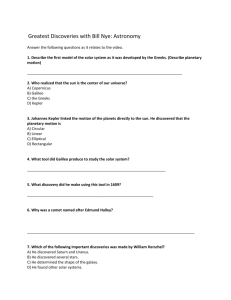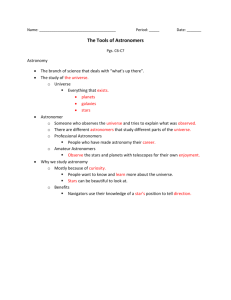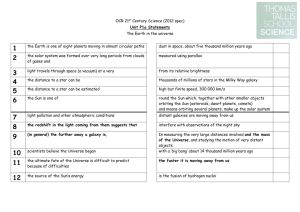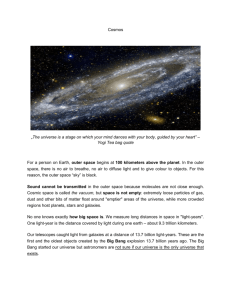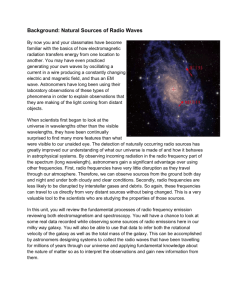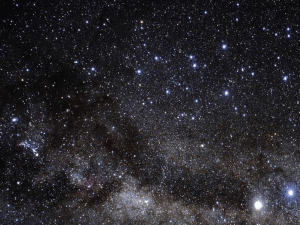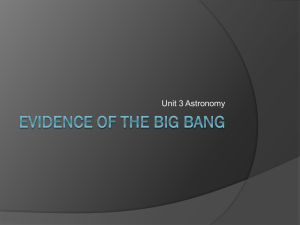Learning Astronomy According to the Classical Method
advertisement
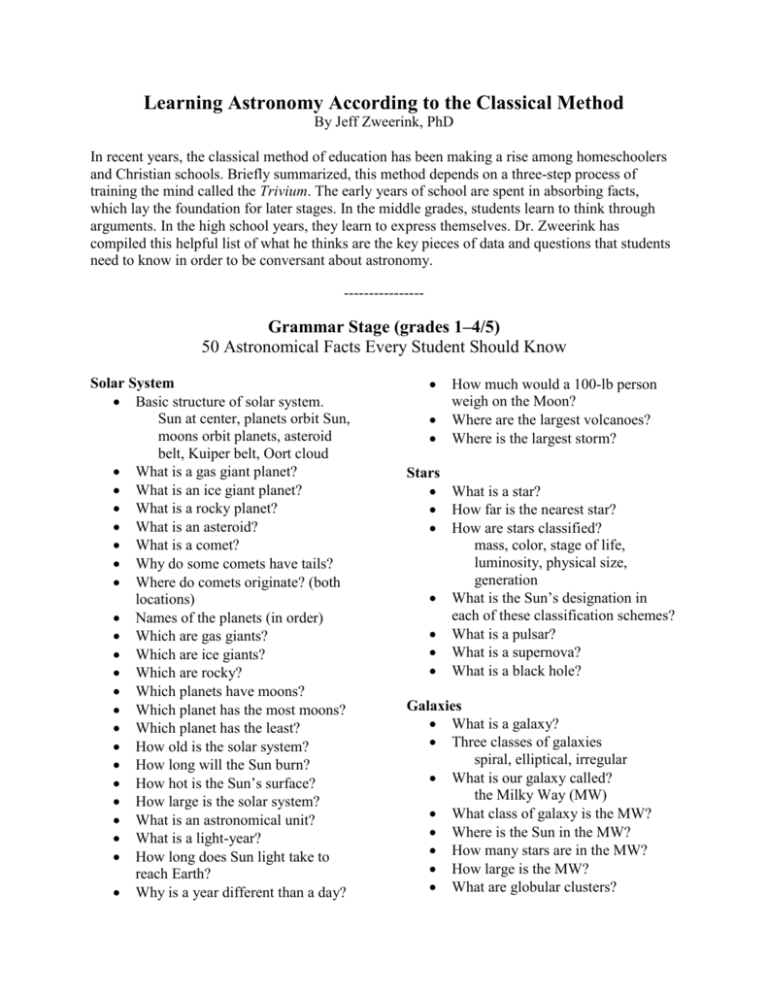
Learning Astronomy According to the Classical Method By Jeff Zweerink, PhD In recent years, the classical method of education has been making a rise among homeschoolers and Christian schools. Briefly summarized, this method depends on a three-step process of training the mind called the Trivium. The early years of school are spent in absorbing facts, which lay the foundation for later stages. In the middle grades, students learn to think through arguments. In the high school years, they learn to express themselves. Dr. Zweerink has compiled this helpful list of what he thinks are the key pieces of data and questions that students need to know in order to be conversant about astronomy. ---------------- Grammar Stage (grades 1–4/5) 50 Astronomical Facts Every Student Should Know Solar System Basic structure of solar system. Sun at center, planets orbit Sun, moons orbit planets, asteroid belt, Kuiper belt, Oort cloud What is a gas giant planet? What is an ice giant planet? What is a rocky planet? What is an asteroid? What is a comet? Why do some comets have tails? Where do comets originate? (both locations) Names of the planets (in order) Which are gas giants? Which are ice giants? Which are rocky? Which planets have moons? Which planet has the most moons? Which planet has the least? How old is the solar system? How long will the Sun burn? How hot is the Sun’s surface? How large is the solar system? What is an astronomical unit? What is a light-year? How long does Sun light take to reach Earth? Why is a year different than a day? How much would a 100-lb person weigh on the Moon? Where are the largest volcanoes? Where is the largest storm? Stars What is a star? How far is the nearest star? How are stars classified? mass, color, stage of life, luminosity, physical size, generation What is the Sun’s designation in each of these classification schemes? What is a pulsar? What is a supernova? What is a black hole? Galaxies What is a galaxy? Three classes of galaxies spiral, elliptical, irregular What is our galaxy called? the Milky Way (MW) What class of galaxy is the MW? Where is the Sun in the MW? How many stars are in the MW? How large is the MW? What are globular clusters? What is the MW’s closest neighbor? Andromeda (LMC?) How far away is Andromeda? What is the massive object at the center of our galaxy? Universe What is the big bang? beginning, expansion, cooling How old is the universe? What is a quasar? Other Do planets exist beyond the solar system? What is a hot Jupiter? What is a super Earth? What kinds of telescopes do astronomers use? radio, microwave, infrared, visible, ultraviolet, x-ray, gamma-ray What is a power of 10? (Eames’ Film) 10 to the third = 1000, 10 to the 15th = 1,000,000,000,000,000 Key Astronomers in History (and what they discovered) Galileo Galilei – Used telescope to observe heavens, discovered moons of Jupiter Tycho Brahe – Catalogued hundreds of stars to unprecedented accuracy, discovered new stars Johannes Kepler – outlined laws of planetary motion Nicolaus Copernicus – developed heliocentric model of solar system Edwin Hubble – discovered the expansion of the universe Arno Penzias and Robert Wilson – discovered cosmic microwave background radiation Logic Stage (grades 5–8) Six Astronomical Descriptions Every Student Should Know 1. How do planets form? Some trigger causes gas cloud to collapse, begin process of star formation To conserve angular momentum, disk of material forms around protostar Dust grains stick together to form clumps Clumps grow by sweep up more matter as they orbit Larger clumps grow even larger using gravity to attract additional Planetesimals clear out lanes around the star, either gathering the material or scattering it to other parts of the disk. Planetesimals collide with one another to form larger and larger bodies In the outer parts of the disk, large enough planetesimals attract a lot of gas to form gas or ice giants In the inner parts of the disk the developing star ejects all the gas before planetesimals grow large enough, resulting in rocky planets Some gas giants may form by another process called “gravitational instability” 2. Why do astronomers think the universe is expanding? Build cosmic distance ladder Parallax for closer stars (in nearby galaxy) Use parallax to calibrate Cepheid variables (brightness related to period) Use parallax to calibrate Type Ia supernovae (brightness roughly constant) Measure distant Cepheids or distant Type Ia supernovae in far away galaxies Measure velocity (redshift) of same galaxies (velocities near speed of light) The farther a galaxy, the faster it is moving away from us 3. How do astronomers find planets outside the solar system? Measure the gravitational tug of a planet on its host star (Doppler effect) Measure the dimming of star as planet moves across its face Directly measure the light from the planet 4. What is the big bang? Universe created in a hot, dense state Only hydrogen, helium after four minutes (small amounts of lithium, beryllium) Continually expands and cools (2.725K currently) Atoms form around 400,000 years after creation (T = 3000K) Stars/galaxies form a few hundred million years later, produce other elements Solar system forms 4.6 billion years ago. Universe experiences heat death (expands until no heat left to perform work). 5. What are the components of the universe? Stars, galaxies made up of normal matter (electrons, protons, neutrons) Galaxy rotation curves, galaxy clusters require “dark matter” Expansion history, galaxy clustering, big bang/inflation requires “dark energy” 6. How do astronomers measure the age of the universe? Expansion history of the universe Oldest stars in the galaxy Abundances of radioisotopes over time Modeling (cosmic microwave background radiation, large scale structure, etc) Rhetoric Stage (grades 9–12) Six Astronomical Questions Every Student Should Know How to Reason Through 1. 2. 3. 4. 5. 6. Is there life elsewhere in the universe? Are there other habitable planets? Did inflation happen? Is there something before the big bang? What are dark matter and dark energy? Is an ancient universe compatible with the Bible?


